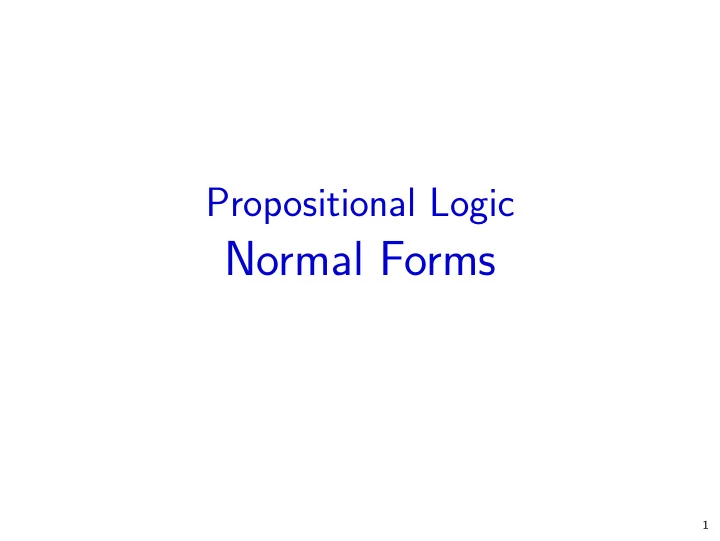

Propositional Logic Normal Forms 1
Literals Definition A literal is an atom or the negation of an atom. In the former case the literal is positive, in the latter case it is negative. 2
Negation Normal Form (NNF) Definition A formula is in negation formal form (NNF) if negation ( ¬ ) occurs only directly in front of atoms. Example In NNF: ¬ A ∧ ¬ B Not in NNF: ¬ ( A ∨ B ) 3
Transformation into NNF Any formula can be transformed into an equivalent formula in NNF by pushing ¬ inwards. Apply the following equivalences from left to right as long as possible: ¬¬ F ≡ F ¬ ( F ∧ G ) ≡ ( ¬ F ∨ ¬ G ) ¬ ( F ∨ G ) ≡ ( ¬ F ∧ ¬ G ) Example ( ¬ ( A ∧ ¬ B ) ∧ C ) ≡ (( ¬ A ∨ ¬¬ B ) ∧ C ) ≡ (( ¬ A ∨ B ) ∧ C ) Warning: “ F ≡ G ≡ H ” is merely an abbreviation for “ F ≡ G and G ≡ H ” Does this process always terminate? Is the result unique? 4
CNF and DNF Definition A formula F is in conjunctive normal form (CNF) if it is a conjunction of disjunctions of literals: n m i F = ( � ( � L i , j )), i =1 j =1 where L i , j ∈ { A 1 , A 2 , · · · } ∪ {¬ A 1 , ¬ A 2 , · · · } Definition A formula F is in disjunctive normal form (DNF) if it is a disjunction of conjunctions of literals: m i n F = ( � ( � L i , j )), i =1 j =1 where L i , j ∈ { A 1 , A 2 , · · · } ∪ {¬ A 1 , ¬ A 2 , · · · } 5
Transformation into CNF and DNF Any formula can be transformed into an equivalent formula in CNF or DNF in two steps: 1. Transform the initial formula into its NNF 2. Transform the NNF into CNF or DNF: ◮ Transformation into CNF. Apply the following equivalences from left to right as long as possible: ( F ∨ ( G ∧ H )) ≡ (( F ∨ G ) ∧ ( F ∨ H )) (( F ∧ G ) ∨ H ) ≡ (( F ∨ H ) ∧ ( G ∨ H )) ◮ Transformation into DNF. Apply the following equivalences from left to right as long as possible: ( F ∧ ( G ∨ H )) ≡ (( F ∧ G ) ∨ ( F ∧ H )) (( F ∨ G ) ∧ H ) ≡ (( F ∧ H ) ∨ ( G ∧ H )) 6
Termination Why does the transformation into NNF and CNF terminate? Challenge Question: Find a weight function w :: formula → N such that w ( l . h . s . ) > w ( r . h . s . ) for the equivalences ¬¬ F ≡ F ¬ ( F ∧ G ) ≡ ( ¬ F ∨ ¬ G ) ¬ ( F ∨ G ) ≡ ( ¬ F ∧ ¬ G ) ( F ∨ ( G ∧ H )) ≡ (( F ∨ G ) ∧ ( F ∨ H )) (( F ∧ G ) ∨ H ) ≡ (( F ∨ H ) ∧ ( G ∨ H )) Define w recursively: w ( A i ) = . . . w ( ¬ F ) = . . . w ( F ) . . . w ( F ∧ G ) = . . . w ( F ) . . . w ( G ) . . . w ( F ∨ G ) = . . . w ( F ) . . . w ( G ) . . . 7
Complexity considerations The CNF and DNF of a formula of size n can have size 2 n Can we do better? Yes, if we do not instist on ≡ . Definition Two formulas F and G are equisatisfiable if F is satisfiable iff G is satisfiable. Theorem For every formula F of size n there is an equisatisfiable CNF formula G of size O ( n ) . 8
Recommend
More recommend